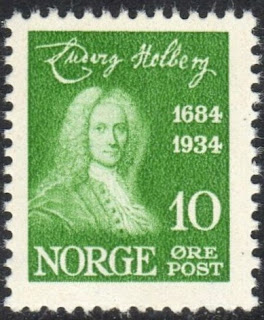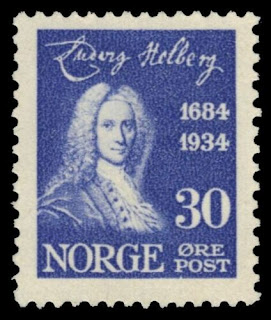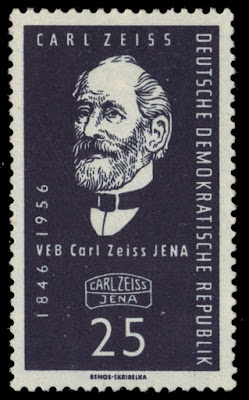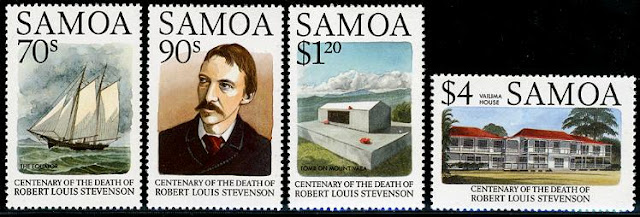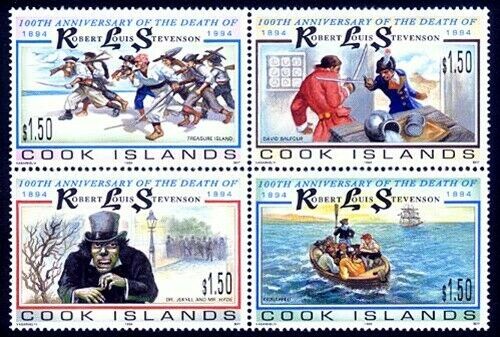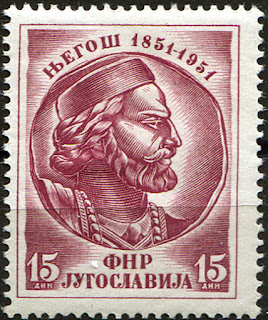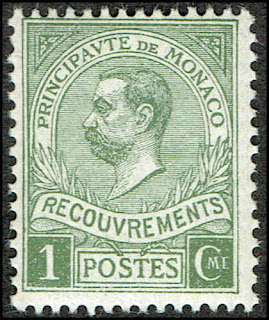1684 Born: Ludvig Holberg, Norwegian historian and writer (d. 1754)
Ludvig Holberg, Baron of Holberg (3 December 1684 – 28 January 1754) was a writer, essayist, philosopher, historian and playwright born in Bergen, Norway, during the time of the Dano-Norwegian dual monarchy. He was influenced by Humanism, the Enlightenment and the Baroque. Holberg is considered the founder of modern Danish and Norwegian literature. He is best known for the comedies he wrote in 1722–1723 for the Lille Grønnegade Theatre in Copenhagen. Holberg's works about natural and common law were widely read by many Danish law students over two hundred years, from 1736 to 1936
Stamps from Norway depicting Ludvig Holberg
1888 Died: Carl Zeiss, German physicist and lens maker, created the optical instrument (b. 1816)
Carl Zeiss (11 September 1816 – 3 December 1888) was a German scientific instrument maker, optician and businessman who founded the workshop of Carl Zeiss in 1846, which is still in business today as Carl Zeiss AG. Zeiss gathered a group of gifted practical and theoretical opticians and glass makers to reshape most aspects of optical instrument production. His collaboration with Ernst Abbe revolutionized optical theory and practical design of microscopes. Their quest to extend these advances brought Otto Schott into the enterprises to revolutionize optical glass manufacture. The firm of Carl Zeiss grew to one of the largest and most respected optical firms in the world.
East German stamps issued commemorating Carl Zeiss and his instruments
1894 Died: Robert Louis Stevenson, Scottish novelist, poet, and essayist (b. 1850)
Robert Louis Stevenson (13 November 1850 – 3 December 1894) was a Scottish novelist and travel writer, most noted for Treasure Island, Kidnapped, Strange Case of Dr Jekyll and Mr Hyde, and A Child's Garden of Verses.
Born and educated in Edinburgh, Stevenson suffered from serious bronchial trouble for much of his life, but continued to write prolifically and travel widely in defiance of his poor health. As a young man, he mixed in London literary circles, receiving encouragement from Andrew Lang, Edmund Gosse, Leslie Stephen and W. E. Henley, the last of whom may have provided the model for Long John Silver in Treasure Island. Stevenson spent several years in search of a location suited to his health, before finally settling in Samoa, where he died.
A celebrity in his lifetime, Stevenson's critical reputation has fluctuated since his death, though today his works are held in general acclaim. He is currently ranked as the 26th most translated author in the world.
His 2 most famous novels
Treasure Island (1883) His first major success, a tale of piracy, buried treasure, and adventure, has been filmed frequently. In an 1881 letter to W. E. Henley, he provided the earliest known title, "The Sea Cook, or Treasure Island: a Story for Boys".
Strange Case of Dr Jekyll and Mr Hyde (1886), a novella about a dual personality much depicted in plays and films, also influential in the growth of understanding of the subconscious mind through its treatment of a kind and intelligent physician who turns into a psychopathic monster after imbibing a drug intended to separate good from evil in a personality.
Stamps from Samoa, Western Samoa and the Cook Islands depicting Robert Louis Stevenson or his works
1919 Died: Pierre-Auguste Renoir, French painter and sculptor (b. 1841)
Pierre-Auguste Renoir, commonly known as Auguste Renoir 25 February 1841 – 3 December 1919), was a French artist who was a leading painter in the development of the Impressionist style. As a celebrator of beauty and especially feminine sensuality, it has been said that "Renoir is the final representative of a tradition which runs directly from Rubens to Watteau."
Renoir's paintings are notable for their vibrant light and saturated color, most often focusing on people in intimate and candid compositions. The female nude was one of his primary subjects. In characteristic Impressionist style, Renoir suggested the details of a scene through freely brushed touches of color, so that his figures softly fuse with one another and their surroundings.
A prolific artist, he created several thousand paintings. The warm sensuality of Renoir's style made his paintings some of the most well-known and frequently reproduced works in the history of art. The single largest collection of his works—181 paintings in all—is at the Barnes Foundation, in Philadelphia
Stamps from France and Yugoslavia depicting Renoir's works
